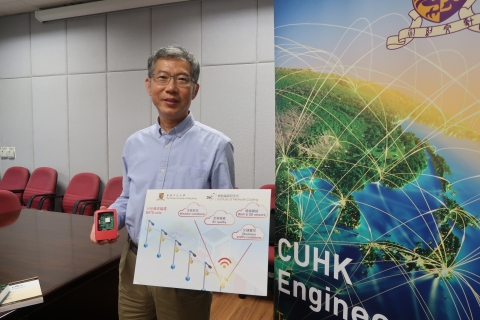A research team led by Prof. Raymond W. Yeung, Choh-Ming Li Professor of Information Engineering and Co-Director of the Institute of Network Coding (INC) at CUHK, has invented BATched Sparse code (BATS code) to improve the network transmission rate of networks with packet loss. It is one of the world’s most mature networking techniques in which transmitted data is encoded and decoded to increase network throughput, reduce delays and make the network more robust. The potential application of BATS code includes a wide spectrum of areas such as Internet of Things (IoT), fog computing, underwater and satellite communication systems and disaster communications, breaking geographical boundaries with technologies. The team is now in the process of applying to Institute of Electrical and Electronics Engineers (IEEE) to make BATS code one of the international wireless communication standards. Pioneering Network Coding Technologies As an efficient linear network coding solution, BATS code replaces routers with coders that transmit ‘evidence’ of a message instead of sending the message itself, and overcomes the problem of data loss during wireless transmission, and offers higher speed, reliability and stability. Compared with conventional random linear network coding, BATS code offers a lower encoding and decoding complexity, and requires a much smaller buffer size at the intermediate nodes. For example, for a multihop network, BATS code can increase the transmission rate by 56% and reduce the loss rate by 29%. With 7 years of Prof. Yeung’s team effort, the performance of BATS code has proven remarkable in making network communications more efficient, reliable, stable and secure. BATS code not only helps to compensate for the network loss, it improves the throughput for multicast with just minimal storage capacities and hardware requirements. In principle, a basic low-power communication hardware will suffice to consistently achieve a high transmission rate for multi-hop wireless networks with hundreds to a thousand nodes (the number of intermediate nodes or liner networks). In other words, this makes BATS code ideal for implementation on multi-functional smart lampposts especially when extra large-scale infrastructure and fiber network upgrade are not needed for transferring data to the server. More importantly, the advantages of BATS code, which include high throughput, low latency and low storage requirement, strongly favour transforming Hong Kong into a smart city. Cross-disciplinary Research Collaborations BATS has already obtained a number of patents in Europe and the US. Thus far, the team has been actively in touch with the Hong Kong Applied Science and Technology Research Institute to explore the opportunities for collaboration on their smart city’s lampposts scheme, with Beijing’s aviation technology units for its application in satellite communication, and with the University in Nova Scotia, Canada for testing of acoustic signals in underground communication. BATS code can particularly tackle the problem of data loss in the ocean, and, in turn, facilitate the civil monitoring process on underwater builds. Looking ahead, Prof. Yeung hopes that by introducing BATS code into hot air balloons or aerial photography, setting up wireless networks and emergency rescue and communication works will become less difficult in remote and hilly districts, and that BATS code will have great potential for benefiting mankind. Meanwhile, the team has been invited to work in different fields on promoting fog computing, a conceptual extension of cloud computing. The objective is to reduce the network congestion and streamline the algorithms and layering. CUHK and INC are the only two institutional members of OpenFog Consortium in Hong Kong. Prof. Yeung remarked, “There is a strong correlation between fog computing and Internet of Things (IoT); for example, the industrial and medical application of smart robots and Internet of Vehicles (IoV), which came under the umbrella of IoT. BATS code is one of the keys to making IoT possible”. The network coding theory which originated at CUHK is a major breakthrough in information sciences. Its fundamental concept was introduced in the late 1990s, largely due to the work of Prof. Raymond Yeung, and has become an innovative network coding technique to revolutionise the world of wireless communications. Prof. Yeung hopes that with this breakthrough technology from CUHK, BATS code will be shared to realise Hong Kong’s smart city vision and its infrastructure-based development, and to make Hong Kong a world-class smart city. Demonstration of a video streaming comparison of BATS and fountain codes in a two-hop network can be viewed at http://iest2.ie.cuhk.edu.hk/~whyeung/BATS.mp4
|
|


